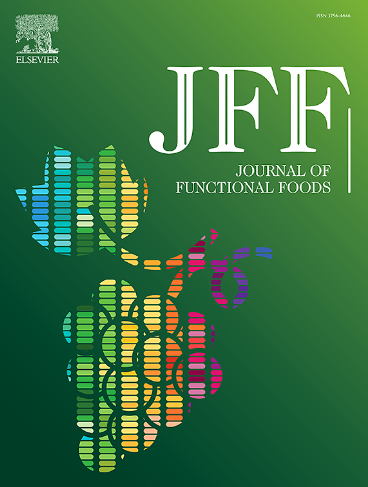Serum pharmacochemistry profiling combined with molecular docking analysis to reveal the pharmacodynamic material basis of Lonicerae japonicae flos against acute lung injury
IF 3.8
2区 农林科学
Q2 FOOD SCIENCE & TECHNOLOGY
引用次数: 0
Abstract
Lonicerae japonicae flos (LJF), a medicine and food homology substance, regulates inflammatory responses. Our preliminary study demonstrated that LJF can intervene in acute lung injury (ALI) through the IL-17 signaling pathway via RNA-seq, yet the material basis remains unclear. Thus, the aim is to investigate the potential targets and pharmacodynamic material basis of LJF against ALI through serum pharmacochemistry and molecular docking. Utilizing ELISA and HE staining, the expression of IL-17C, IL-17F, CXCL2, and CXCL6 was notably downregulated in the LJF group, leading to an improvement in alveolar histological structure damage and a reduction in lung inflammation. Consequently, compared with the ALI group, western blotting results revealed that the expression levels of IL-17F proteins were significantly decreased in the LJF group, confirming IL-17F as the primary target. Subsequently, in accordance with the serum pharmacochemistry theory of traditional Chinese medicine, a total of 30 blood-absorbed ingredients were screened in the LJF. Molecular docking demonstrated that isochlorogenic acid B exhibited strong binding affinity with the IL-17F targets. The results of in vitro experiments indicated that isochlorogenic acid B suppressed the expression of the downstream signaling pathways MAPK and NF-κB by targeting IL-17F, subsequently reducing the levels of inflammatory mediators to treat ALI. In light of physiological and pathological insights, this study has pinpointed the characteristic constituents and blood-absorbed ingredients of LJF. It has also identified the key active components and potential targets associated with its anti-ALI effects, thereby elucidating the pharmacodynamic basis of LJF in the prevention of acute lung injury.

血清药物化学分析结合分子对接分析揭示金银花抗急性肺损伤的药效学物质基础
金银花(Lonicerae japonicae flowers, LJF)是一种药食同源物质,具有调节炎症反应的作用。我们的初步研究表明,LJF可通过RNA-seq途径通过IL-17信号通路干预急性肺损伤(ALI),但其物质基础尚不清楚。因此,通过血清药物化学和分子对接,探讨LJF抗ALI的潜在靶点和药效学物质基础。ELISA和HE染色结果显示,LJF组IL-17C、IL-17F、CXCL2和CXCL6的表达明显下调,肺泡组织结构损伤改善,肺部炎症减轻。因此,与ALI组相比,western blotting结果显示,LJF组IL-17F蛋白的表达水平显著降低,证实IL-17F是主要靶点。随后,根据中医血清药物化学理论,在LJF中共筛选出30种血吸收成分。分子对接表明,异绿原酸B与IL-17F靶点具有较强的结合亲和力。体外实验结果表明,异绿原酸B通过靶向IL-17F抑制下游信号通路MAPK和NF-κB的表达,从而降低炎症介质水平,治疗ALI。本研究结合生理病理方面的认识,明确了LJF的特征成分和血吸收成分。并鉴定了其抗ali作用的关键活性成分和潜在靶点,从而阐明了LJF预防急性肺损伤的药效学基础。
本文章由计算机程序翻译,如有差异,请以英文原文为准。
求助全文
约1分钟内获得全文
求助全文
来源期刊

Journal of Functional Foods
FOOD SCIENCE & TECHNOLOGY-
CiteScore
9.60
自引率
1.80%
发文量
428
审稿时长
76 days
期刊介绍:
Journal of Functional Foods continues with the same aims and scope, editorial team, submission system and rigorous peer review. We give authors the possibility to publish their top-quality papers in a well-established leading journal in the food and nutrition fields. The Journal will keep its rigorous criteria to screen high impact research addressing relevant scientific topics and performed by sound methodologies.
The Journal of Functional Foods aims to bring together the results of fundamental and applied research into healthy foods and biologically active food ingredients.
The Journal is centered in the specific area at the boundaries among food technology, nutrition and health welcoming papers having a good interdisciplinary approach. The Journal will cover the fields of plant bioactives; dietary fibre, probiotics; functional lipids; bioactive peptides; vitamins, minerals and botanicals and other dietary supplements. Nutritional and technological aspects related to the development of functional foods and beverages are of core interest to the journal. Experimental works dealing with food digestion, bioavailability of food bioactives and on the mechanisms by which foods and their components are able to modulate physiological parameters connected with disease prevention are of particular interest as well as those dealing with personalized nutrition and nutritional needs in pathological subjects.
 求助内容:
求助内容: 应助结果提醒方式:
应助结果提醒方式:


